|
|
|
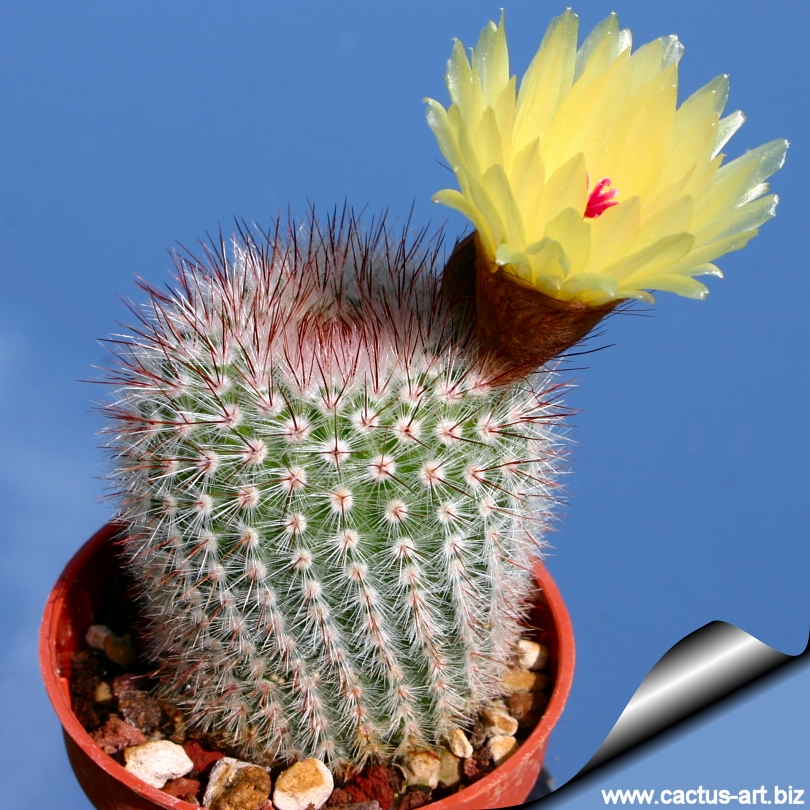
Notocactus scopa (Locality: Laguna Garzon)
It has very pretty, soft, silvery-white, fir-like spines, often
with red centrals. The exciting lemon-yellow flowers with pale anthers
and scarlet stigma open during the day and close at night.
|
|
Morphology (Identifying
Characteristics):
Habit: Silvery green cactus often clustering
with showy yellow flowers. The stems are
almost hidden by soft
tufts of bristly spines somewhat similar to small brushes. The
mixture of white and red-brown spines, varying from plant to plant.
Stem: Dark green,
at
first globular, becoming bit columnar
to clavate with age, depressed apically, up to 45 cm
tall, 6-10 cm in diameter.
Ribs: 25-30 (sometime up to 40 or more) low, obtuse, finely
notched into low warts tipped with areoles, which may spiral slightly.
Areoles: White woolly.
Central spines: About 4 (but
varying from 2 to 12) medium length (6-12 mm long), needle-like, stouter
than radials,
purple, red-brown,
orangish or white.
Radial spines:
Shorter,
fine, bristles-like, glassy white or yellowish, 5-7 mm long, spreading
around.
Flower: A cluster of satiny,
bright yellow flowers spring in the upper part of the stem forming a
ring, The are 2-4 cm long and 3,5-4,5 cm in diameter. Inner
perianth segments in two overlapping series, spatulate, rather wide for
their length, ± toothed above, Pistil with about 10, rayed, bright
crimson stigma lobes. Tube short. Scales on the ovary woolly with brown
bristles.
Blooming: seson: June-July.
Fruit: Globose, about 7 mm in diameter, opening at maturity, with
numerous seeds.
Seeds: Dull black tuberculate.
ssp. scopa:
Ribs 30-40, central spines 4, radial spines glassy white more than
40. Origin: Southern Brazil and Paraguay.
ssp. marchesii: Ribs 19-28, central spines 2-4, radial spines
about 40. Origin: Uruguay.
Ssp. neobuenekeri: Ribs: 18-21, central spines 6-12 stout. Origin: Rio
Grande do Sul. Brazil.
ssp. succinea: Ribs 18-24, central spine 8-12, Radial spines
15-30 often yellowhish. Origin: Rio Grande do Sul. Brazil.
|
|
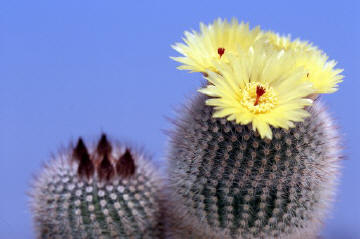
Photo
and © copyright by
Andrea
B. (Bologna, Italy)
It has very pretty, soft,
white, fir-like spines, often with red centrals. The satiny and
canary-yellow flowers are born on
apical clusters and form rings, they open during the day and
close at night. |
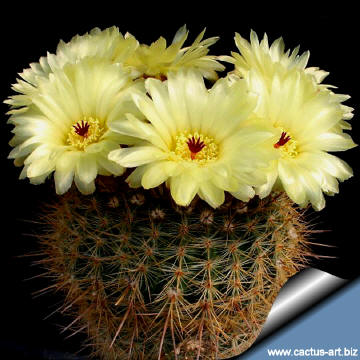 |
|
. |
|
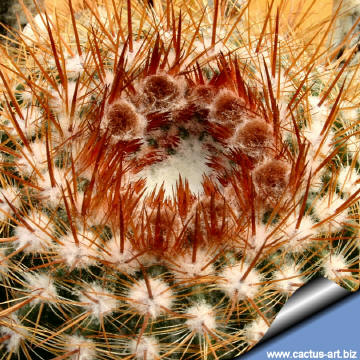 |
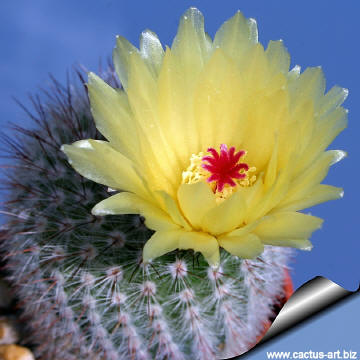 |
|
. |
|
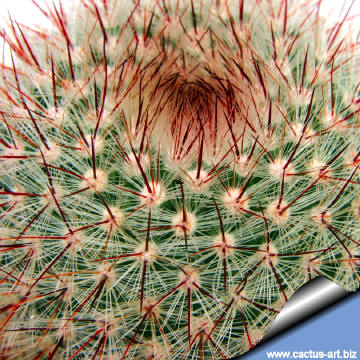 |
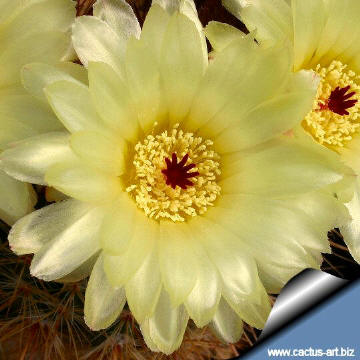 |
|


Advertising
|
|
|
|
|
|
|
Family:
Cactaceae
(Cactus
Family)
Scientific Name:
Notocactus scopa (Sprengel) Backeberg
Published
in: Backeb. & F. M. Knuth, Kaktus-ABC,
256, 1935
(Notocactus scopa (Spreng.)
A.Berger
Published
in: A.Berger -- Kakteen, 208, 343
1929
Basionym:
Cactus scopa
Sprengel
Published
in: Systema
Vegetabilium, 2:494, Göttingen 1825
Distribution:
Southern Brazil (Rio Grande do Sul),
Uruguay, Paraguay, northern Argentina.
Habitat:
Native to the grasslands
Conservation status:
Listed in
CITES
Appendix II
The Notocactus
scopa aggregate is an ensemble of related species comprising
N. scopa,
N. schlosseri, N. scopa var. xicoi, N. sucineus
NOTE: This
plant has been Transferred to Parodia in
1997 by David Hunt.
Etymology:
The
genus name "Notocactus"
derives from the Greek words “notos” meaning “south”
indicating that the plants of this genus are from of the South (America)
and the word “cactus” ( an old genus name)
(The genus name implies:
“cactus of the south”).
The
species name
"scopa"
derives from the Latin word “scopa (
pl. scopæ )
” meaning “a broom”, referring to the long
and dense spination.
(The specific name implies:
“broom like”)
Common English Names include:
Silver Ball Cactus,
Silver ball.
Synonyms:
- Parodia scopa (Sprengel)
N.P. Taylor 1987
- Cereus scopa Salm-Dick
In De Candolle, Prodr. 3464.
1828
- Echinocactus scopa Link
and Otto
In: Icon Pl. Rar. 81. 1830
- Echinocactus scopa candidus
Pfeiffer
In: Enum. Cact. 64. 1837
- Echinopsis scopa
Carriére
In: Rev. Hort. 47:374. 1875
- Echinocactus scopa albicans
Arechavaleta
In: Anal. Mus. Nac. Montevideo
5:199 1905
- Malacocarpus scopa (Sprengel)
Britton & Rose 1922
- Notocactus scopa (Sprengel)
A. Berger 1929
- Notocactus scopa (Link &
Otto) A.Berger
Published
in: Kakteen (Berger) 343. 1929
- Notocactus soldtianus
- Peronocactus scopa
|
|
|
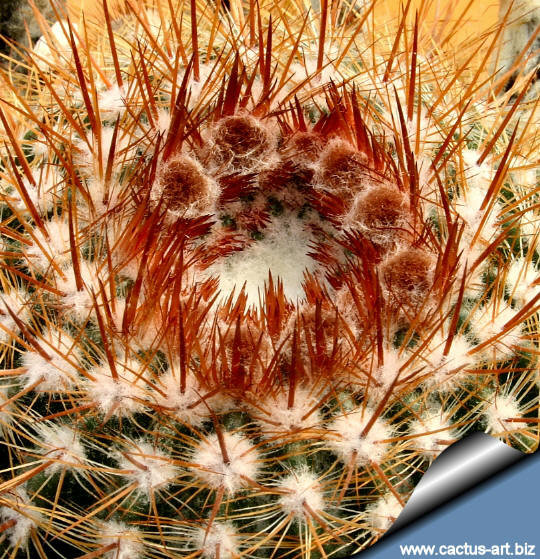
Red central spines and shorter white around.
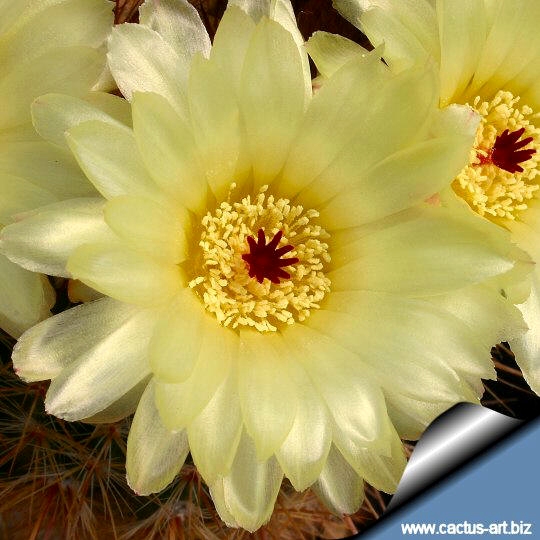
Yellow bloom with contrasting red pistil. |
|
Cultivation: It
is easy to grow. It
prefers a neutral to slightly acidic
mineral-based potting mix with a good
drainage.
It likes a warm bright location, does great in partial shade but doesn't like
full, hot blazing sun in the central summer month.
Can support quite some water during the growing season
but pot plants in winter are
wet-sensitive and
needs to be kept
dry (rots easily if soil is wet and cold) tends to lose
its roots in winter.
Usually it is recommended to
over-winter
this plant in a bright and warm greenhouse with at least 8-10° C ,
but it has proved to tolerate temperatures as low as -5° C for short
periods.
Propagation: Seeds,
cuttings or root suckers (if available). Not too difficult to raise from seed.
|
|
Photo of conspecific taxa, varieties, forms and
cultivars of plants belonging to the
Notocactus scopa
complex:
|
|